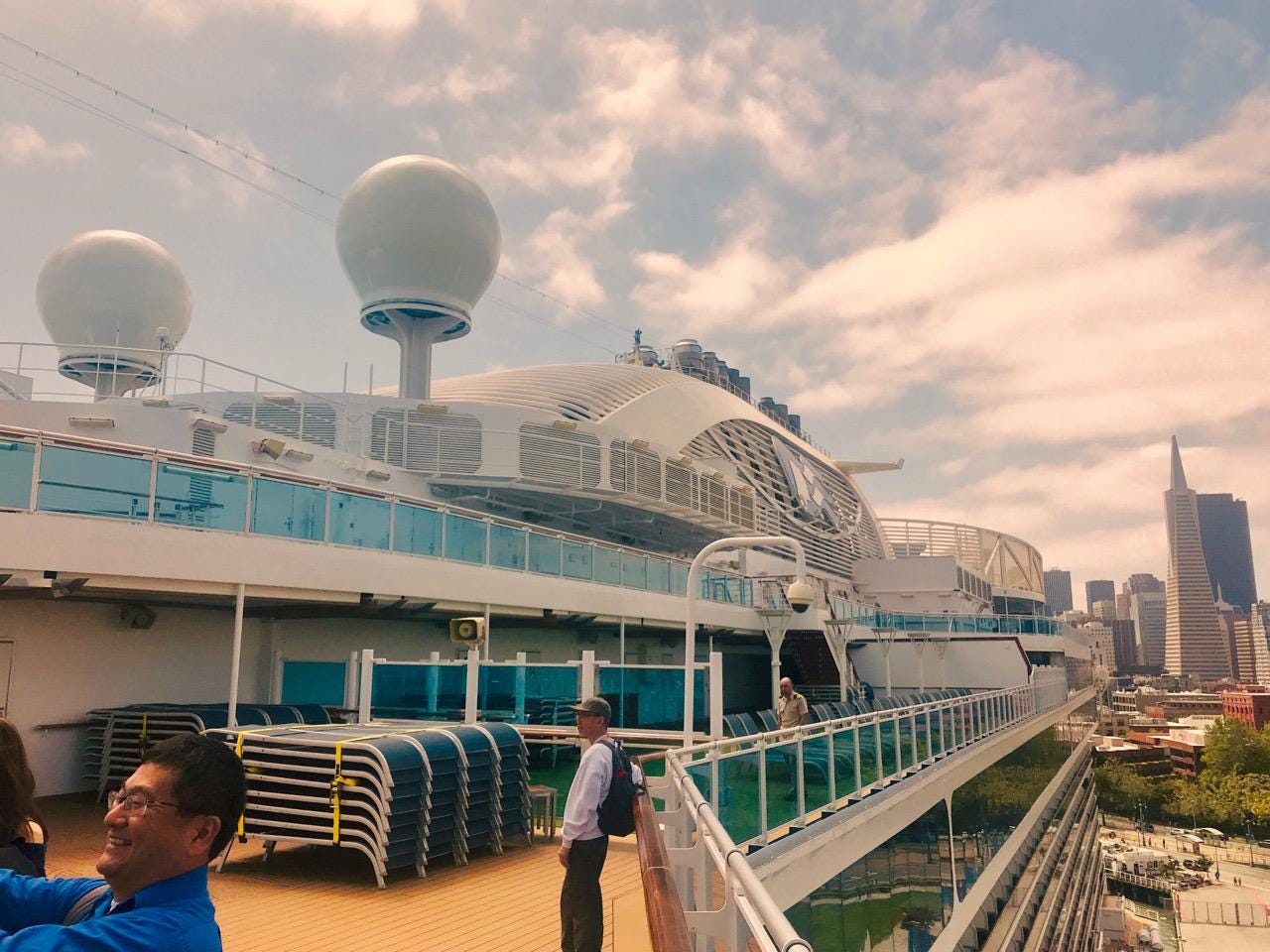The Internet of Things enables a floating city of pleasure... and a vision of hell


Large round satellite data links can be seen on top of The Royal Princess docked in San Francisco.
I was recently invited onto the Royal Princess cruise ship docked in San Francisco to see what Carnival is calling the largest Internet of Things deployment and how it and other wireless technologies such as passenger location improve the cruise experience.
It was the first time Carnival had invited journalists to see what it has dubbed as the "first real example of a smart city."
Every passenger carries a wireless Bluetooth and NFC-enabled medallion about the size of a fat 25-cent coin. Through a massive network of sensors and edge computing devices, the medallion controls the opening and closing of cabin doors, ordering drinks, delivery of food and other services, and in emergencies it ensures no one is left behind.
The medallion system kicks-in as they board the ship and their identities are confirmed from photos they uploaded. Their location is then known at all times to the ship's captain through a large dashboard near the bridge that also shows the exact location of each of the ship's workers (tracked through iPads).
This location data is used in many ways -- like by cleaning staff to service a cabin when they notice it is empty. Previously, they had to rely on knocking or other signs of vacancy. It's also used to deliver drinks and food directly to the passenger wherever they are on the boat. And the medallion automatically unlocks their cabin door well before the passenger reaches it.
Drinks and food are automatically charged to the passenger's account (alcohol consumption is not monitored or flagged and no data is retained). The medallion is also used for funds in the ship's casino. Large touch screens by the elevators (there are 14 floors plus three restricted to staff) allow passengers to find and track each other. Passengers can choose to be untraceable to their companions but not to the ship's system, unless they totally forgo the medallion and use the old card based system, which rarely happens.
In addition, there are various apps and games enabled by the medallions throughout the ship.
The cruise ship has two data centers and is outfitted with connections to several high-speed satellite Internet access services that is offered to passengers for less than $10 a day -- matching land-based hotels and vacation facilities.
With a maximum of 4,272 passengers and 1,350 crew, the Carnival installation likely is the largest individual IoT installation. It's currently installed on three ships, and it will be installed on all 17 ships within the next two years -- a tough job because of all the wireless-blocking steel, and each ship has less than two weeks of downtime every three years.
Foremski's Take
What is the IoT?
The cruise ships are massive and the IoT data generated provide a real-time picture of the ship's most valuable cargo: Its passengers and crew. There are tremendous low-hanging fruits to be gained in terms of efficiency, and the provision of new services. These ships are technology-enhanced cities of pleasure.
Carnival said it is looking at plans to install these types of IoT systems in land-based entertainment facilities, and it says those technologies might even have application in hospitals, which have a similar set of challenges in linking clients with a variety of services and improving their "experience."
A city of pleasure can also be configured in other ways. It's not a stretch to see how a Carnival IoT-type installation in a real city would function. It could improve linking residents with a variety of vital city services, etc. And also commercial services could be made available -- creating a platform for a vibrant local economy.
Carnival has chosen to configure their system for pleasure. But there's also a strong dystopian potential if this type of technology were configured by others: Doors opening only for the right people, huge privacy issues in tracking every person in real time, denial of services.
Entire buildings could be closed to certain residents, and interactions between individuals could be monitored. There's thousands of ways such a system could be abused and used to oppress a population.
These technologies could create a city of hell just as easily as they can be used to create a city of pleasure. Digital technologies, however, are neutral and don't deserve a dystopian reputation straight out of their box. It's their application that is never neutral.
Many Silicon Valley technologists subscribe to the notion that technology critics should get out of the way and allow technologies like IoT to find their own level within society, even when there are some negative effects. That's a disastrous strategy, in my humble opinion, because every technology use has an agenda: It is not neutral.
We all have a shared future, we all have a share in how we want to live in that future. Technology always has a purpose. But without an active dialog, the potential for an abusive Big Brother-like city situation is inevitable and will gradually creep in until it's too late.
I worry we could inadvertently paint ourselves into a corner -- for all the right reasons -- and find ourselves blocked into a hellish tech-enabled oppressive society.
Imagine a future with superior Big Brother technologies monitoring everything you do and say -- and judging and punishing you in real time. China is already experimenting with such systems.
We should not get out of the way of technology. We should choose the type of future we want -- not the one we just happen to get. Carnival's cruise ships show that we can choose a city of pleasure.